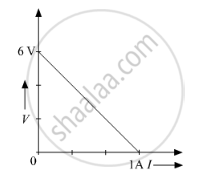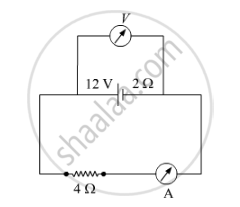Advertisements
Advertisements
प्रश्न
The plot of the variation of potential difference across a combination of three identical cells in series, versus current is shown below. What is the emf and internal resistance of each cell ?

उत्तर १
Let E and r be the EMF and internal resistance of all cells respectively and e and r' be the EMF and internal resistance of each cell respectively.
As we know,
According to the definition of the terminal potential difference,
V = E − Ir
E is the EMF and r is the total internal resistance of the circuit.
I = 0 ⇒ V = E
From the graph we can see
E = 6 V
As there are three cells we can write,
E = 3 × e ⇒ e = 2 V
And, when, V = 0
⇒ E = Ir
`r=E/T=6/1=6Omega`
As per the question the cells are connected in the series, so we can write.
`r'=r/3=2Omega`
उत्तर २
Since there are three cells connected in series, Total EMF = E1 + E2 + E3
We can observe from the graph that,
E1 + E2 + E3 = 6
3E = 6 (E = E1 = E2 = E3, as they are identical cells)
hence, The EMF of each cell is 2Volt.
Now, similarly, the internal resistance is also 2 Ohm for each, because in series combination of cells not only the Emf the internal resistance also gets added up.
APPEARS IN
संबंधित प्रश्न
Two cells of emfs 1.5 V and 2.0 V, having internal resistances 0.2 Ω and 0.3 Ω, respectively, are connected in parallel. Calculate the emf and internal resistance of the equivalent cell.
A battery of emf 12 V and internal resistance 2 Ω is connected to a 4 Ω resistor as shown in the figure.
(a) Show that a voltmeter when placed across the cell and across the resistor, in turn, gives the same reading.
(b) To record the voltage and the current in the circuit, why is voltmeter placed in parallel and ammeter in series in the circuit?

In a potentiometer arrangement, a cell of emf 1.25 V gives a balance point at 35.0 cm length of the wire. If the cell is replaced by another cell and the balance point shifts to 63.0 cm, what is the emf of the second cell?
The earth’s surface has a negative surface charge density of 10−9 C m−2. The potential difference of 400 kV between the top of the atmosphere and the surface results (due to the low conductivity of the lower atmosphere) in a current of only 1800 A over the entire globe. If there were no mechanism of sustaining atmospheric electric field, how much time (roughly) would be required to neutralise the earth’s surface? (This never happens in practice because there is a mechanism to replenish electric charges, namely the continual thunderstorms and lightning in different parts of the globe). (Radius of earth = 6.37 × 106 m.)
Nichrome and copper wires of same length and same radius are connected in series. Current I is passed through them. Which wire gets heated up more? Justify your answer.
In a potentiometer arrangement for determining the emf of a cell, the balance point of the cell in open circuit is 350 cm. When a resistance of 9 Ω is used in the external circuit of the cell, the balance point shifts to 300 cm. Determine the internal resistance of the cell.
Do all thermocouples have a neutral temperature?
Answer the following question.
A cell of emf E and internal resistance r is connected across a variable resistor R. Plot the shape of graphs showing a variation of terminal voltage V with (i) R and (ii) circuit current I.
If n cells each of emf e and internal resistance r are connected in parallel, then the total emf and internal resistance will be ______.
The internal resistance of a cell is the resistance of ______
